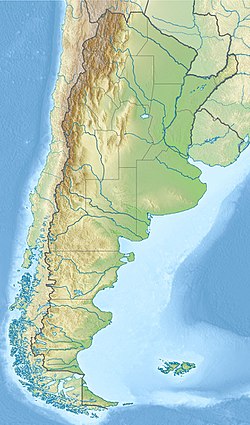Top Qs
Timeline
Chat
Perspective
Anacleto Formation
Geologic formation in Argentina From Wikipedia, the free encyclopedia
Remove ads
The Anacleto Formation is a geologic formation with outcrops in the Argentine Patagonian provinces of Mendoza, Río Negro, and Neuquén. It is the youngest formation within the Neuquén Group and belongs to the Río Colorado Subgroup. Formerly that subgroup was treated as a formation, and the Anacleto Formation was known as the Anacleto Member.[1]
The type locality of this formation lies 40 kilometres (25 mi) west of the city of Neuquén. At its base, the Anacleto Formation conformably overlies the Bajo de la Carpa Formation, also of the Río Colorado Subgroup, and it is in turn unconformably overlain by the Allen Formation of the younger Malargüe Group.[2]
The Anacleto Formation varies between 60 and 90 metres (200 and 300 ft) thick, and consists mainly of claystones and mudstones, purple and dark red in color, deposited in fluvial, lacustrine and floodplain environments. Geodes are often found scattered throughout this formation.[3]
Remove ads
Fossil content
Summarize
Perspective
Color key
|
Notes Uncertain or tentative taxa are in small text; |
The following animals are known from bones found in the Anacleto Formation:
Crocodylomorphs
Dinosaurs
Ornithischians
Sauropods
Nests of dinosaur eggs, many with preserved embryos inside, have been discovered in large quantities at the famous Auca Mahuevo locality, and have been attributed to titanosaurs.[6]
Theropods
The oldest known unequivocal bird footprints from South America were discovered in the Anacleto Formation. The small footprints were tentatively assigned to the ichnogenus Aquatilavipes and might have been produced by Patagopteryx (whose fossils were only found in the Bajo de la Carpa Formation however) or some unknown wader-like bird; they lack a hind toe. Ignotornis refers to similar footprints made by larger birds with a small hind toe; they might have been left by Neuquenornis, but this is also only known from the Bajo de la Carpa Formation. Footprints of these two ichnogenera have also been found elsewhere, but it must be understood that assignment to the same ichnogenus does not imply a close relatedness of the organisms that produced these traces, only a similar morphology.[15]
Even smaller and somewhat unusual footprints assigned to Barrosopus are only known from the Anacleto Formation. They were almost certainly made by some tiny theropod, but whether this was a bird is not quite clear: the innermost front toes of the animal leaving these tracks attached in a position higher than the others. In that, and in their dimensions, they are a very close match for the odd-footed enantiornithine bird Yungavolucris brevipedalis, but this is only known from the Maastrichtian Lecho Formation which is some 10 million years younger.[16]
Squamates
Testudines
Remove ads
See also
References
Further reading
Wikiwand - on
Seamless Wikipedia browsing. On steroids.
Remove ads












